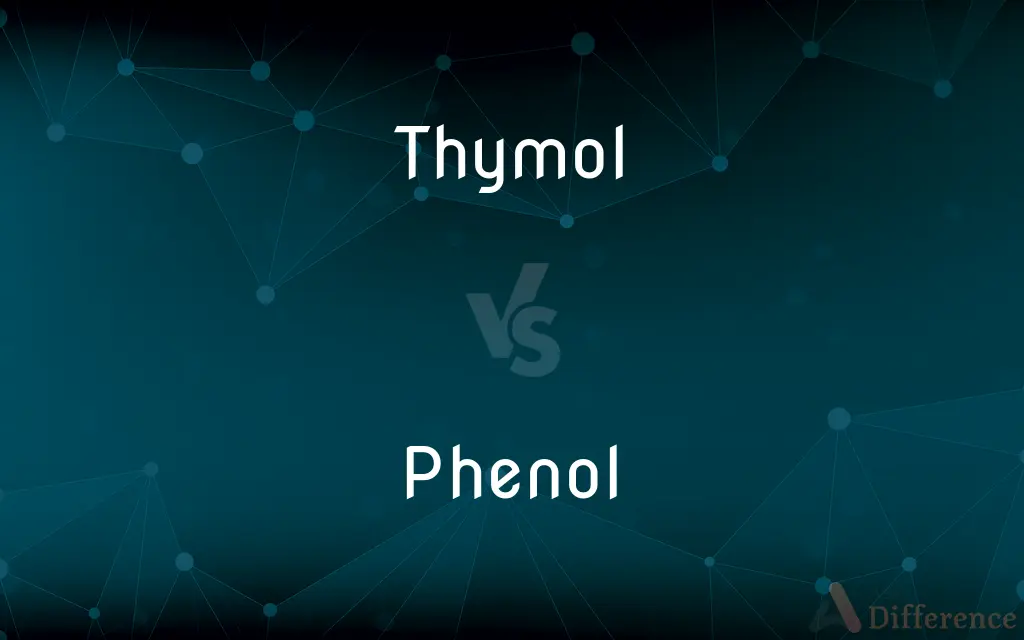Thymol vs. Phenol — What's the Difference?

Difference Between Thymol and Phenol
ADVERTISEMENT
Compare with Definitions
Thymol
Thymol (also known as 2-isopropyl-5-methylphenol, IPMP) is a natural monoterpenoid phenol derivative of p-Cymene, C10H14O, isomeric with carvacrol, found in oil of thyme, and extracted from Thymus vulgaris (common thyme), Ajwain and various other kinds of plants as a white crystalline substance of a pleasant aromatic odor and strong antiseptic properties. Thymol also provides the distinctive, strong flavor of the culinary herb thyme, also produced from T. vulgaris.
Phenol
Phenol (also called carbolic acid) is an aromatic organic compound with the molecular formula C6H5OH. It is a white crystalline solid that is volatile. The molecule consists of a phenyl group (−C6H5) bonded to a hydroxy group (−OH).
Thymol
A white, crystalline, aromatic compound, C10H14O, derived from thyme oil and other oils or made synthetically and used as an antiseptic, a fungicide, and a preservative.
Phenol
A mildly acidic toxic white crystalline solid obtained from coal tar and used in chemical manufacture, and in dilute form (under the name carbolic) as a disinfectant.
Thymol
(chemistry) a monoterpene phenol, C10H13OH, found in the oil extracted from thyme; used as in perfume, as an antiseptic and fungicide, and in embalming
ADVERTISEMENT
Phenol
A caustic, poisonous, white crystalline compound, C6H6O, derived from benzene and used in resins, plastics, and pharmaceuticals and in dilute form as a disinfectant. Also called carbolic acid.
Thymol
A phenol derivative of cymene, C10H13.OH, isomeric with carvacrol, found in oil of thyme, and extracted as a white crystalline substance of a pleasant aromatic odor and strong antiseptic properties; - called also hydroxy cymene.
Phenol
Any of a class of aromatic organic compounds having at least one hydroxyl group attached directly to the benzene ring.
Thymol
A colorless crystalline solid used in perfume or preserving biological specimens or in embalming or medically as a fungicide or antiseptic
Phenol
A caustic, poisonous, white crystalline compound, C6H5OH, derived from benzene and used in resins, plastics, and pharmaceuticals and in dilute form as a disinfectant and antiseptic; once called carbolic acid
Phenol
Any of a class of aromatic organic compounds having at least one hydroxyl group attached directly to the benzene ring (or other aromatic ring)
Phenol
A white or pinkish crystalline substance, C6H5OH, produced by the destructive distillation of many organic bodies, as wood, coal, etc., and obtained from the heavy oil from coal tar.
Phenol
Any one of the series of hydroxyl derivatives of which phenol proper is the type.
Phenol
Any of a class of weakly acidic organic compounds; molecule contains one or more hydroxyl groups
Phenol
A toxic white soluble crystalline acidic derivative of benzene; used in manufacturing and as a disinfectant and antiseptic; poisonous if taken internally
Share Your Discovery

Previous Comparison
Solely vs. Sole
Next Comparison
Superior vs. Senior














































